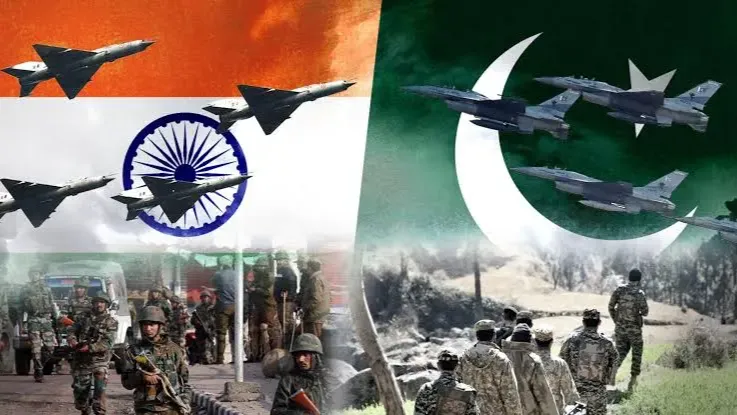Deadly Terror Attack Sparks Fresh Crisis
On April 22, 2025, a deadly terrorist attack in Pahalgam, Kashmir, killed 26 people, mostly Hindu tourists. The attack was linked to The Resistance Front (TRF), which is backed by Pakistan-based terror group Lashkar-e-Taiba. This event has renewed fears of a major India Pakistan war. India quickly blamed Pakistan and responded by suspending the Indus Waters Treaty, launching civil defense drills, and increasing military activity near the Line of Control (LoC). Pakistan also responded with missile tests and military alerts.
Why India and Pakistan Are Constantly in Conflict
The root of the India Pakistan conflict lies in the Kashmir dispute, which dates back to the partition of 1947. The two countries have already fought four wars and numerous battles over this region. Kashmir remains divided but fully claimed by both sides. Attacks like the 2001 Indian Parliament bombing and the 2019 Pulwama attack have previously brought the nations close to war.
This latest attack has sparked similar calls for retaliation. India alleges that Pakistani nationals trained by its military were behind the attack. In return, Pakistan has denied involvement and even suspended the Simla Agreement. This back-and-forth has brought both countries dangerously close to a new conflict.
Pahalgam Attack: A Major Turning Point
The April 22 attack in Baisaran Valley, Pahalgam, killed 25 Indian tourists and 1 Nepali citizen. The terrorists reportedly targeted Hindus specifically. India quickly identified the attackers, including two from Pakistan, and accused them of receiving military training.
India reacted by suspending the Indus Waters Treaty, banning Pakistani imports, sealing borders, and launching civil defense drills across 244 districts. Meanwhile, Pakistan expelled Indian diplomats, blocked airspace, and test-fired missiles. Border skirmishes began on April 24 and have continued daily.
India Pakistan War Risks Getting Out of Control
Current events show signs of rapid escalation. India’s cancellation of the water treaty is seen by Pakistan as an “act of war.” The ongoing fighting near the LoC, now into its second week, could turn into larger air or ground strikes.
India faces domestic pressure for a strong response. Ruling party BJP and public protests demand justice. The opposition also supports retaliation. In Pakistan, military leaders are promising a “tit-for-tat” response, despite limited resources for a prolonged war.
A major concern is that either country could miscalculate, leading to a sudden and uncontrollable war—especially without proper communication channels in place.
Nuclear Threat in India Pakistan War
Both India and Pakistan have nuclear weapons. India has about 172 warheads, and Pakistan has 170, according to global estimates. Even a small nuclear exchange would cause massive deaths and create a global disaster. A study shows that if only 30% of nuclear weapons are used, tens of millions could die immediately, and a nuclear winter could follow, destroying agriculture worldwide.
India follows a “no first use” nuclear policy. Pakistan, however, has said it may use nuclear weapons if its territory is invaded. This mismatch increases the risk of a nuclear war if a ground operation occurs.
Global Reaction to India Pakistan War Threat
World leaders have condemned the attack and called for peace, but real action has been limited. The UN urged both countries to avoid war. Iran, Russia, and Qatar have tried to support peace efforts. The U.S. and China also advised restraint but are focused on other global issues. There’s little coordinated action to prevent further escalation.
China’s involvement in Pakistan through trade and infrastructure makes things more complex. India might hesitate to strike if China could get involved. Overall, the global community is watching, but not doing enough to prevent disaster.
Economic Impact of India Pakistan War Tensions
The conflict is already affecting both economies. Pakistan’s stock market has dropped 4%, while India’s has risen slightly. India’s ban on Pakistani imports doesn’t affect much trade but sends a strong political message. However, cutting water flow from the Indus could seriously hurt Pakistan’s agriculture.
In Kashmir, security has tightened. Thousands have been detained, homes of suspected terrorists demolished, and tourism has collapsed. This increases local resentment and hurts the economy.
India is also seeing rising communal tensions. Arrests have been made for pro-Pakistan comments, and civil defense drills are being promoted by the government.
How the India Pakistan War Could Begin
Here are key ways a war could start:
- Surgical Strikes: India could launch air or ground strikes on terrorist camps, triggering a major Pakistani response.
- Ground Invasion: If India sends troops into Pakistan-controlled areas, Pakistan might respond with tactical nuclear weapons.
- Misjudgment: Border violence, aircraft being shot down, or political miscommunication could cause rapid escalation.
- New Terror Attack: Another attack, especially in a major city, could push India to respond forcefully.
Diplomatic pressure, economic isolation, or action against terrorists by Pakistan could still help avoid war, but the current path points toward growing conflict.
Global Risks of a Nuclear India Pakistan War
A nuclear war between India and Pakistan would not just hurt South Asia. The global effects could include:
- Global temperatures dropping by 2–5°C due to smoke from fires
- Crop failures in major countries like the U.S. and Russia
- Massive global famines
- Collapse of food supply chains and rise in food prices
- Harm to ecosystems from ozone loss and increased UV exposure
No country would be safe from the consequences. Developing nations depending on food imports would be hit hardest.
What Must Be Done to Avoid War
To prevent war, both nations must take steps now:
- Agree to a ceasefire at the LoC
- Restart diplomatic talks
- India could reconsider suspending the Indus Waters Treaty
- Pakistan must act seriously against terrorist groups
A joint investigation of the Pahalgam attack could be a step toward rebuilding trust. International players like the U.S., China, and the UN must become more involved.
In the long run, both countries need to address the Kashmir issue. India’s harsh tactics and Pakistan’s support of militants are both fueling violence. A peaceful solution, possibly with help from neutral countries, is the only way forward.
Conclusion: Avoiding a Disaster
The situation between India and Pakistan is extremely dangerous. The Pahalgam attack has brought both countries close to war. While nuclear weapons might prevent full-scale war, limited military actions could still spiral out of control.
The risk is not only regional but global. A nuclear India Pakistan war could cause massive death and suffering across the world. Leaders must act now—with diplomacy, communication, and long-term solutions—to avoid the worst-case scenario.
India Pakistan War tensions are rising—debate, discuss, and dissect it all with us on Discord!
Click here to read our latest article- USD Dominance.



